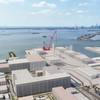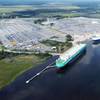Increased Japanese steel production has driven Booming Capesize rates more than the August market raid by Belgium's Bocimar when it chartered about 35 ships, shipping sources said.
Capesize spot rates have doubled over the last three months, with the market now looking for $15-16,000 for a Pacific round trip, compared with about $7,500 in August, brokers said. Atlantic rates have also soared, although partly due to the grounding of the 274,326-dwt ore carrier Weser Ore at Tubarao in Brazil last week.
"The whole market has moved on the back of Japanese steel activity," said one shipping broker. "Bocimar has done very well and will be very happy with what it has achieved," the broker said. In August, he described Bocimar's chartering dawn raid as a gamble that could spectacularly succeed or fail.
Bocimar managing director Marc Saverys said all the ships had been chartered out, and that rate returns were good so far. "You just have to look at the indices in early August and compare them with now," he said, "but it was not us making the market," Saverys said. He agreed that Japanese economic revival was propelling the Capesize recovery.
On Oct. 8, the Baltic Exchange Capesize index soared 111 points to 1,677. In early August it was under 1,000.
Brokerage firm SS&Y reported on Oct. 11 its Atlantic Capesize index had risen 532 points to 4,400 -- some 1,500 points above the same period last year, and close to pre-Asian crisis levels in 1997. SS&Y said conditions would remain firm while the Japanese steel industry remained strong.
Japanese steel production is forecast to hit 95-96 million tons this year from 88.8 million last year, with increased production coming mainly in the second half.
Brokers said that would mean increased raw material movements should take place from October onward. "I see no reason why rates should not rise further as long as the market is there," Saverys said.
However, some brokers said there could be a dip over the millennium period after stockpiling toward the end of the year. "The question is whether Bocimar will refix the early ships when they come back on the market at higher rates," one broker said.
Around a quarter of the ships were taken for six to eight months -- potentially bringing them back onto the market between March and May next year. Saverys said Bocimar would like to retain the same volume of ships if possible, but would not start deciding on re-fixing until around February. However, he said he did not necessarily see a millennium factor, as he was not aware of massive stockpiling taking place.
Subscribe for
Maritime Reporter E-News
Maritime Reporter E-News is the maritime industry's largest circulation and most authoritative ENews Service, delivered to your Email five times per week










